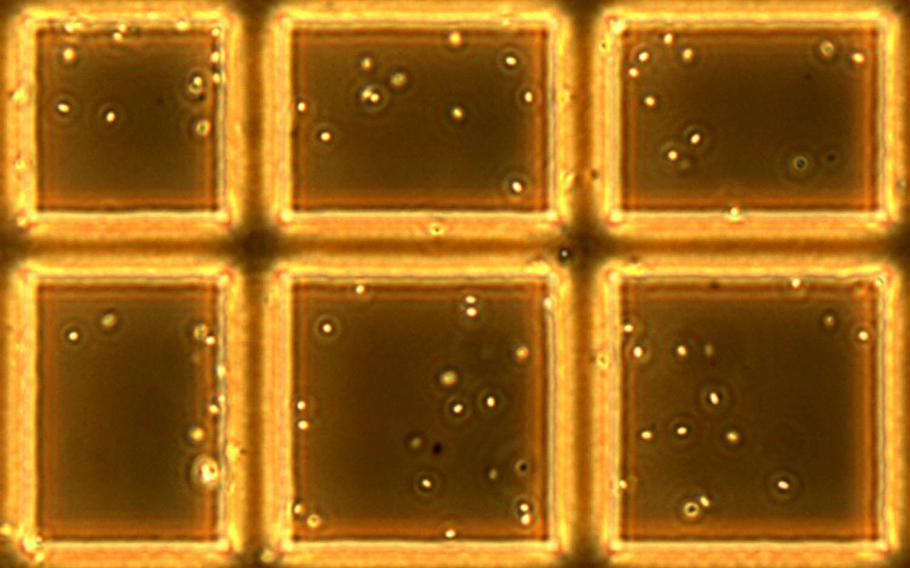
This undated image from the National Institute of Standards and Technology shows anthrax bacillus spores under a microscope in a cell chamber to measure their concentration. Last year, it was revealed that the Army made 575 shipments of anthrax that was not completely inactivated to 194 labs and contractors around the world from 2004 to 2015 from its Dugway Proving Ground Sciences Division in Utah. (Courtesy of NIST)
The number of times that dangerous pathogens are not properly “deactivated” for safe scientific study is considerably higher than what’s been reported by agencies overseeing such research, a federal audit says.
The discrepancy arises because laboratories are not required to report such incidents in enough detail, according to a report issued Wednesday by the Government Accountability Office.
Last year, it was revealed that the Army made 575 shipments of anthrax spores that were not completely inactivated to 194 labs and contractors around the world from 2004 to 2015 from its Dugway Proving Ground Sciences Division in Utah. Lab technicians believed the spores had been rendered inactive, but the process used had failed to do so. No one was reported to have been sickened by the anthrax.
However, the safety gap has remained unresolved. In February, Dr. Gerald Parker, a retired Army colonel who once commanded the U.S. Army Medical Research Institute of Infectious Diseases at Fort Detrick, Md., told a House committee that without better management of biosecurity, incidents such as this “will happen again somewhere in the nation’s laboratory network with a worse outcome.”
The DOD is reviewing best practices to inactivate anthrax spores by irradiation, the report said.
The Select Agent Program oversees U.S. laboratories that use certain dangerous pathogens that have been inactivated to destroy their hazardous qualities while retaining other characteristics for study.
The program regulates the use and transfer of select agents and is operated by the Department of Health and Human Services and the Department of Agriculture. The National Institutes of Health provides oversight and guidelines for “recombinant” pathogens artificially created in a lab.
But the program does not require labs to submit data on incidents where inactivation was incomplete, the GAO said.
The review examined the extent of incidents of incomplete inactivation of pathogens from 2003 through 2015 at federal, private and public labs in the United States.
The Select Agent Program identified 10 incidents during that period, but the GAO discovered an additional 11 cases during its investigation.
“Because the program cannot easily identify incidents involving incomplete inactivation, it does not know the frequency or reason they occur, making it difficult to develop guidance to help mitigate future incidents,” the GAO said.
The 21 incidents involved a mix of pathogens, including Ebola and Marburg viruses and bacteria associated with tularemia, botulism, melioidosis and equine encephalitis.
Agency officials told the GAO that none of the incidents resulted in “human infection, severe illness, or death.”
Just over half of the 21 cases occurred at federal labs. More than a third of the cases involved anthrax.
But the true number of such incidents is not known for several reasons.
First, the Select Agent Program does not use a reporting form to specifically identify this type of incident.
Federal regulation does require reporting of any incidents of theft, loss or release of select agents, but the reporting forms do not include a subset category about whether an incident involves incomplete inactivation, the report said.
Second, federal incident reporting is required only for incidents that involve certain agents. This omits a pathogen such as West Nile virus from reporting requirements.
Third, there is “currently no clear and consistent definition of inactivation in guidance or regulations” issued by any of the federal agencies involved, the report said.
Among the GAO’s recommendations are development of clear definitions of inactivation, revision of reporting forms to more accurately chronicle incidents of failed inactivation and improved documentation of where and when shipments of agents are made to facilities around the world.
olson.wyatt@stripes.com Twitter: @WyattWOlson